Life Lessons From My First Car: The Story of Blue
How a mystical ’92 Mustang taught me about love and loss.
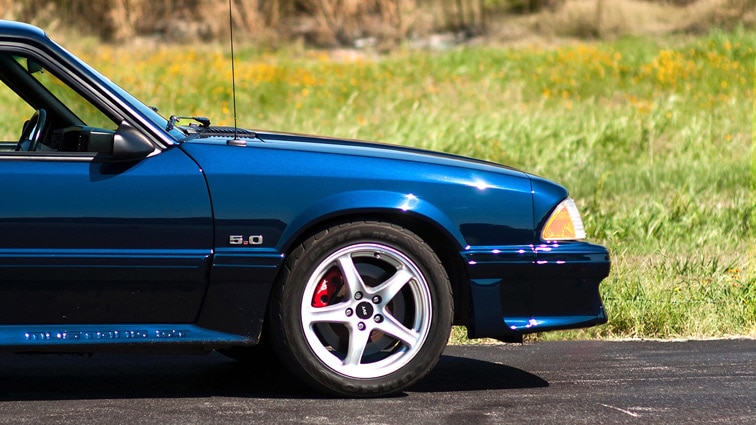 Aaron Miller
Aaron Miller
For generations, non-car people have cried, “It’s just a car!” after injustices like door dings, fender benders, and the careless tracking of mud onto floor mats. To many people, cars are little more than a necessary evil, a method of conveyance best bought used, under warranty, and painted in the Champagne-silver hues of suburban camouflage.
The way I see it, if someone views cars as an appliance—an expensive washing machine with fancy paint—then they’re missing out on both the pivotal role cars play in our lives, and the deep emotional bond possible between man and machine.
Suffice it to say, I’m on the other end of the spectrum.
I remember many of the most important moments in my life through the car I was driving at the time. For over 16 years, so many of those moments were tied to one vehicle: Blue. My first car, a 1992 Mustang GT, became one of the threads around which my life’s memories are eerily woven. It was as if Blue had a preordained and mystical presence in my life. I loved—and hated—that car like a family member.
This is the story of Blue.
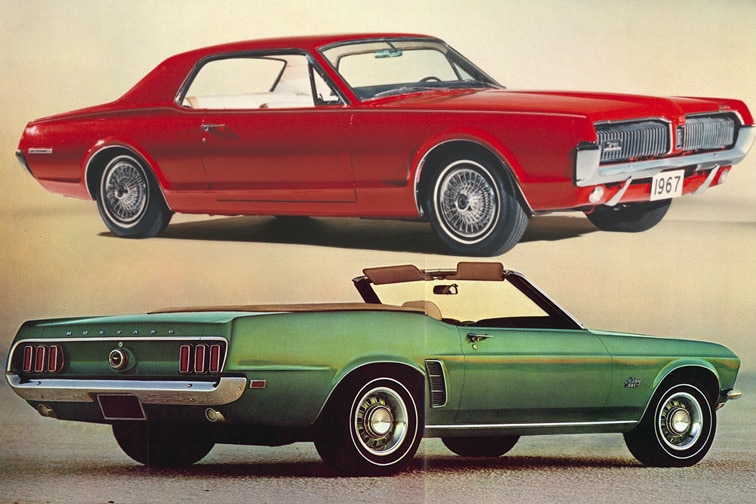 Ford
Ford
Growing up Mustang
During my formative years, the temple of Mustang was the closest I came to a church. I don’t own one today, and likely never will again because there’s simply too much emotion entangled in them. I grew up in what you might call a Ford house. My mom’s first car was a Highland Green ’68 Mustang convertible with eight cylinders and three pedals. My dad owned two Cougar XR-7s—essentially the Mercury version of Mustang in the 1960s—including the first
Even my first die cast car was a Shelby Cobra.
By the time I was 15, there wasn’t much to think about: I was going to buy a
My obsession with performance was incorrigible, and I spent six months detailing that Brougham, ensuring that every inch was as close to perfect as a seven-year-old Cadillac could be before deeming it fit to sell. I took out a classified ad in the newspaper and priced the car at $10,000, or about 15% above market value. Incredibly, I got my asking price, and subsequently bought my Mustang on August 23, 1996.
Some thought I was mad selling a Cadillac to buy a Mustang, but my singular focus was such that the Caddy literally never registered in my brain as my first car.
There I was, still 15 years old, and the proud owner of a 1992 Mustang GT in Twilight Blue. It was a good moment. In a stroke of amazing originality, I named it Blue.
I couldn’t even drive it yet.
My mom taught me how to drive a manual in that car, and the first time I tried putting it in reverse I wound up peeling out and going 30 mph—backwards—in a parking lot. Somehow, we came to a stop without hitting anything, and as the tire smoke cleared, I was shaking with a toxic mix of fear and frustration. The child in me wanted to quit. A lifetime of being condemned to automatic transmissions flashed before my eyes. The gearhead in me (and my mom in the passenger seat) knew I had no choice but to keep trying.
That was the first life lesson Blue taught me.
 Aaron Miller
Aaron Miller
Blue basically controlled my love life
On a Friday afternoon not long after I turned 16, I washed my car in the driveway ahead of my first real date. I was struck by the sheer beauty of the deep metallic blue as it glowed in the Texas sun. Later that evening, when it was time to take my date home, we were serenaded by the heart-sinking sound of a dead battery. The moment had all the hallmarks of a cheesy 1950s movie, wherein teenagers pretend to be out of gas. I’m sure she thought I was faking it...until I pulled out jumper cables and set about finding someone to give us a jump. Our relationship was short lived, but at least I learned how to replace an alternator.
The next year, I fell in love for the first time, and Mustangs and manual transmissions played an integral role. I was a junior, and had a stereotypical high school crush on a senior who was way out of my league. After gathering the courage to ask her out (and succeeding!), I learned that she drove a Mustang. My response? “I’m going to judge you for the rest of your life based on this next question.” “Ask me,” she said. “Manual or automatic?” “Manual” and she just smiled, as the answer warmly washed over me.
Flash forward to college, and my roommate was dating a girl with the most amazing friend...who happened to think I was the ultimate nerd. She liked my car, though, and put up with me pestering her for a date. We went to Chili’s—I never said I was suave in those days—and in my desperation to sound smart, I told her the story of Carroll Shelby, a tiny West Texas ghost town called Terlingua, and the chili cook-off where he agreed to give his then-son-in-law a loan to
And it ominously coincided with my worst years
One month to the day after I got my car, my mom was diagnosed with Stage 3 Inflammatory Breast Cancer and given 90 days to live. The doctors estimated it had started one month prior, which was the exact day I bought my beloved Blue. What followed were countless surgeries and extreme, experimental doses of chemotherapy and radiation, but she was still with us six months later, albeit ravaged by the cancer and the treatment.
As my mom’s cancer progressed, two things were obvious: first, that she was going to beat the hell out of the 90-day prognosis, and second, that she was still likely to lose eventually. My dad and I bought her a Mustang—an Emerald Green 1992 5.0L LX hatchback. She loved it, and even asked me one night if I could “soup it up,” to make it sound more like mine. She drove it right up until her body was too weak to push in the clutch.
Appropriately, it was raining on the day of her funeral. We had a couple of limos for family members, but my dad and I rode in that green Mustang, driven by a friend of mine—whom I had taught to drive a manual using my Mustang a couple of years prior. It was a soggy and cool March morning, and I just remember laughing to myself every time the wheels spun upon hitting an extra-slick painted stripe at a crosswalk.
No matter what, I would always be “just some kid” in Blue
One day, shortly before I got my license, Mom picked me up from school in Blue, wearing a scarf on her chemo-bald head. Windows down. Stereo on. Just enjoying a drive in a Mustang as she had since she was young. According to the officer that pulled her over, she was doing 51 mph in a 35. The minute he saw her, he was profusely apologetic for deigning to pull over a 50-year-old woman so clearly battling an advanced form of cancer. He thought she was “just some kid,” he explained. As he tried to get away and announced his intention to give her a warning, she calmly laid into him, accusing him of gender and age bias. “If it were my son,” she said, “you wouldn’t think twice about giving him a ticket.” She threatened to report him to his superiors, “if you don’t write me a [bleeping] ticket.” She meant it as a lesson to me: people will judge me based on the car I drive just like so many judge based on clothing or skin color.
She got a ticket; I got the message.
In those years, Mustangs became the ultimate bonding machine
The Broncos were playing the Falcons in Super Bowl XXXIII. It was my senior year in high school, and my parents let me invite a few friends over to watch the game. As halftime began, my dad came in and said, “let’s go.” We piled into both cars, with me behind the wheel of Blue, and my dad driving my mom’s green Mustang. With nothing but a desolate, wide, and straight road in front of us, mine should’ve been the faster car. I lost a drag race to my dad that night in front of everyone, and even though as an adult I passionately condemn street racing, that moment remains a memory I’ll forever cherish.
After my mom died, Dad bought a couple more Mustangs. The first was one of
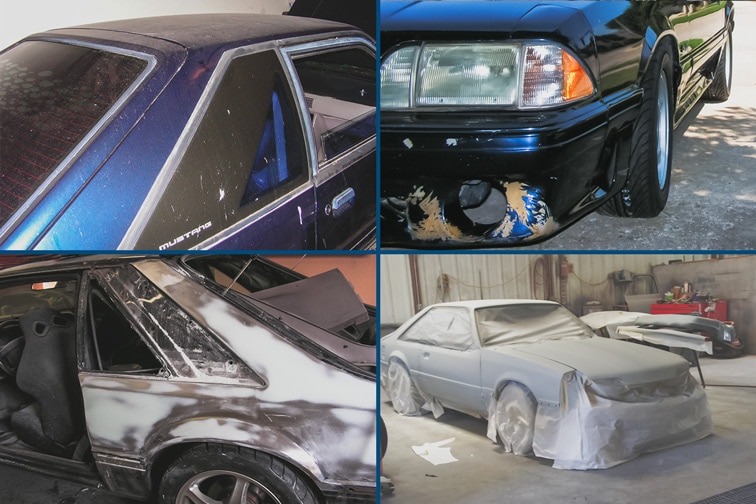 Aaron Miller
Aaron Miller
Blue became a barometer of my well-being
Dad crashed that Cobra in spectacular fashion—spinning through a lamp post and removing two wheels in the process—after I declined to be baited into a race between the Cobra and the Green Mustang. Looking back, those cars and the time he spent with me in them when I was home from college was all that he lived for after Mom died. My dad was barely a shadow of himself, a ghost without my mom, and he ended his own life before the Cobra could be repaired.
My own mental state took a nosedive—losing both parents between the ages of 19 and 21 will do that to you—and Blue took a beating as well. In the course of events, it went to live on a farm for a couple of years, and that’s not a metaphor. It sat for a year in a barn before being pushed out into the open by a tractor, where it was subjected to the harsh extremes of Texas weather for another year before I was ready to see it again.
I don’t know what people thought of me during those years, and I don’t care. Blue was my very own Picture of Dorian Gray. While I looked healthy, at least from the outside, Blue went from a cool and immensely popular car to a weathered and beaten junker. It took a few years, but I slowly restored both myself and my first car, making Blue into the car I always dreamed it could be. In the other parts of my life, I grew into the mature adult my parents always hoped I would become. I had graduated college, been accepted into law school, and begun the process of truly finding myself.
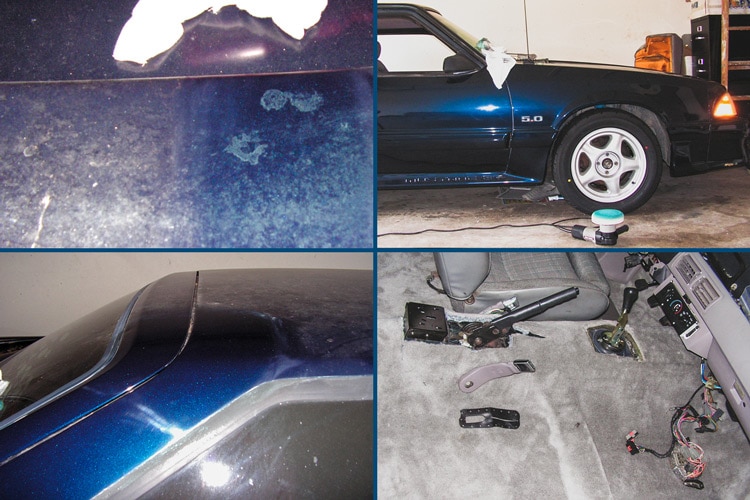 Aaron Miller
Aaron Miller
The car became an educational project
Blue’s once-beautiful paint was destroyed from its time outside. Before having it repainted, I taught myself how to properly use a random orbital polisher, knowing there was no risk. I learned what could and couldn’t be removed with light polishes, and I even experimented with wet sanding. I learned how to turn a wrench as I upgraded the brakes and suspension, and just as importantly, I learned when it was time to consult a professional when the wiring proved a bridge too far during an ill-fated attempt to retrofit antilock brakes from a newer Mustang. I ripped out every piece of the interior and either replaced or repainted it. To this day, I’ve not seen a finer Fox Mustang than Blue. For several years, it was once again a magnificent daily driver.
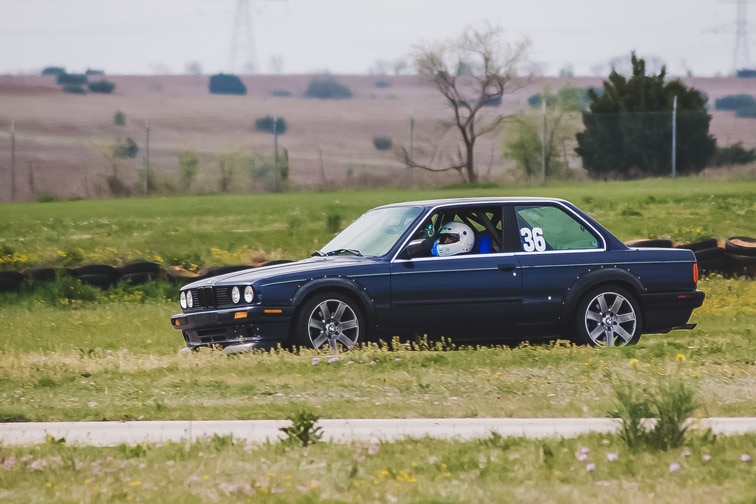 Aaron Miller
Aaron Miller
We inevitably grew apart
As I was doing all this—with both the help and patience of the woman I would later marry—I realized that for everything Blue was, it wasn’t the one thing I really wanted by that point in my life. I wanted a dedicated track car, with which I could pursue the only dream I’d ever had: learning the art of performance driving.
I parked Blue in favor of something more reliable. I periodically drove it just to circulate fluids, but a mysterious drain on the battery meant I had to get a rolling start and pop the clutch every single time I left.
I never did track down that drain.
When Blue died, it felt like a member of the family
Just a couple minutes before 5 a.m. on the morning of November 29th, 2012, Blue died.
According to the officer who watched the security camera footage, it was stolen by someone “dressed in all black, like a ninja.” The kicker was that it started right up for the not-so-kindly stranger.
The stages of grief were exactly like mourning an extended family member. In my denial, I only hoped that the thief somehow knew to use the fog light switch to turn on the auxiliary fan if the water temperature climbed too high, lest the engine overheat before I could recover my beloved car. When it finally sunk in that Blue was surely dismantled within hours of being stolen, I hoped the culprits cut themselves on every crag I’d hit over the years. I searched Craigslist for months, hoping to no avail to find even a single recognizable part.
In time, I accepted Blue’s passing, though I don’t think I’ll ever own another Mustang. There’s simply too much emotion wrapped up in it, both good and bad, and besides, I’ve truly moved on in terms of my automotive tastes. I struggled mightily for years about whether I’ll ever own another blue car, but I probably will. My cars will always be too important to me, too much an extension of my soul, to allow them to blend in with the ambient traffic.
Written by humans.
Edited by humans.
 Aaron Miller
Aaron MillerAs a veteran automotive journalist, I have been fortunate enough to drive some of the most desirable cars on the planet and get to know some of the most important people in the industry. Before joining Capital One, I served as the Cars Editor for a major national website, and covered industry news and analysis for well-known automotive-specific sites. I also wrote feature articles and reviews for niche enthusiast websites. I’ve been obsessed with cars since—literally—before I can remember, with my collection of die-cast and slot cars taking center stage during my formative years. Simply put, for me, working isn’t really “work.”
Related articles
View more related articles